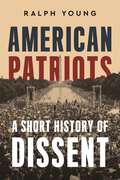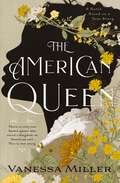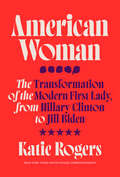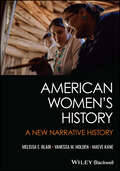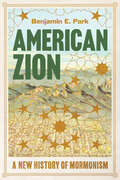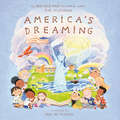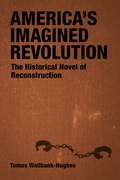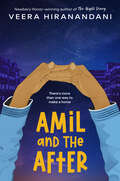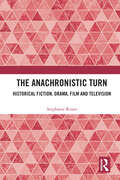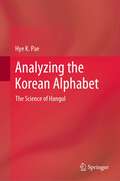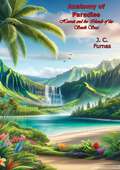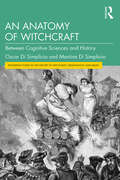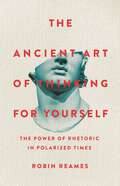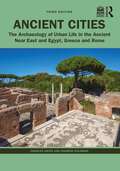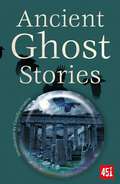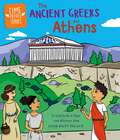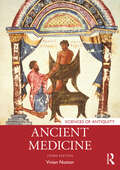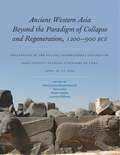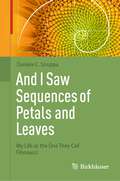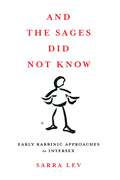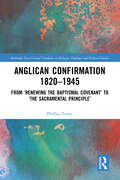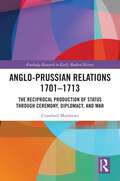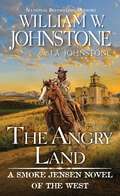- Table View
- List View
American Patriots: A Short History of Dissent
by Ralph YoungA concise history that proves that dissent is patrioticThe history of America is a history of dissent. Protests against the British Parliament’s taxation policies led to the American Revolution and the creation of the United States. At the Constitutional Convention the founders put the right to protest in the First Amendment of the Bill of Rights. In the nineteenth century, dissenters protested against the War of 1812 and the Mexican War, they demanded the abolition of slavery, suffrage for women, and fair treatment for workers. In the twentieth century, millions of Americans participated in the Civil Rights Movement, the antiwar movement, and second-wave feminism. In the twenty-first century, hundreds of thousands protested the war in Iraq, joined the 2011 Occupy movement, the 2017 Women’s March, and the 2020 Black Lives Matter uprisings. The crowds grew larger than ever, but the sentiments expressed were familiar. There have been dissenting Americans for as long as there has been an America.In American Patriots, historian Ralph Young chronicles the key role dissent has played in shaping the United States. He explains that activists are not protesting against America, but pushing the country to live up to its ideals. As he guides the reader through the history of protest, Young considers how ordinary Americans, from moderates to firebrands, responded to injustice. He highlights the work of organizations like SNCC and ACT UP, and he follows iconic individuals like Ida B. Wells-Barnett and Woody Guthrie, charting the impact of their dissent. Some of these protesters are celebrated heroes of American history, while others are ordinary people, frequently overlooked, whose stories show that change is often accomplished through grassroots activism.Yet not all dissent is equal. In 2021, thousands of rioters stormed the US Capitol, and Americans on both sides of the aisle watched the destruction with horror. American Patriots contrasts this attack with the long history of American protest, and challenges us to explore our definition of dissent. Does it express a legitimate grievance or a smokescreen for undermining democracy? What are the limits of dissent? Where does dissent end and sedition begin?In a time when legitimate dissent is framed as unpatriotic, Young reminds us of the dissenters who have shaped our country’s history. American Patriots is a necessary defense of our right to demand better for ourselves, our communities, and our nation.
The American Queen
by Vanessa MillerThere is only one known queen who truly ruled a kingdom on American soil.Transformative and breathtakingly honest, The American Queen is based on actual events that occurred between 1865 - 1889 and shares the unsung history of a Black woman who built a kingdom as a refuge for the courageous people who dared to dream of a different way of life. As seen on Good Morning America: GMA 15 New Books to Read!Over the twenty-four years she was enslaved on the Montgomery Plantation, Louella learned to feel one thing: hate. Hate for the man who sold her mother. Hate for the overseer who left her daddy to hang from a noose. Hate so powerful there's no room in her heart for love, not even for the honorable Reverend William, whom she likes and respects enough to marry.But when William finally listens to Louella's pleas and leads the formerly enslaved people off the plantation, Louella begins to replace her hate with hope. Hope that they will find a place where they can live free from fear. Hope that despite her many unanswered prayers, she can learn to trust for new miracles.Soon, William and Louella become the appointed king and queen of their self-proclaimed Kingdom of the Happy Land. And though they are still surrounded by opposition, they continue to share a message of joy and goodness--and fight for the freedom and dignity of all.The American Queen weaves together themes of love, hate, hope, trust, and resilience in the face of great turmoil. With every turn of the page, you will be transported to a pivotal period in American history, where oppressed people become extraordinary heroes.
American Wings: Chicago's Pioneering Black Aviators and the Race for Equality in the Sky
by Sherri L. Smith Elizabeth WeinFrom the acclaimed author of Flygirl and the bestselling author of Code Name Verity comes the thrilling and inspiring true story of the desegregation of the skies.&“This beautiful and brilliant history of not only what it means to be Black and dream of flying but to, against every odd, do so, completely blew me away.&” —Jacqueline Woodson, National Book Award Winner for Brown Girl DreamingIn the years between World War I and World War II, aviation fever was everywhere, including among Black Americans. But what hope did a Black person have of learning to fly in a country constricted by prejudice and Jim Crow laws, where Black aviators like Bessie Coleman had to move to France to earn their wings?American Wings follows a group of determined Black Americans: Cornelius Coffey and Johnny Robinson, skilled auto mechanics; Janet Harmon Bragg, a nurse; and Willa Brown, a teacher and social worker. Together, they created a flying club and built their own airfield south of Chicago. As the U.S. hurtled toward World War II, they established a school to train new pilots, teaching both Black and white students together and proving, in a time when the U.S. military was still segregated, that successful integration was possible.Featuring rare historical photographs, American Wings brings to light a hidden history of pioneering Black men and women who, with grit and resilience, battled powerful odds for an equal share of the sky.
American Woman: The Transformation of the Modern First Lady, from Hillary Clinton to Jill Biden
by Katie RogersThe first definitive exploration of the changing role of the twenty-first-century First Lady, painting a comprehensive portrait of Jill Biden—from a White House correspondent for The New York Times&“A fascinating and deeply researched exploration into the most public facing and least understood role in Washington.&”—Kate Andersen Brower, #1 New York Times bestselling author of The Residence and First WomenSince the Clinton era, shifts in media, politics, and pop culture have all redefined expectations of First Ladies, even as the boundaries set upon them have often remained anachronistic. With sharp insights and dozens of firsthand interviews with major players in the Biden, Obama, Trump, Bush, and Clinton orbits, including Jill Biden and Hillary Clinton, New York Times White House correspondent Katie Rogers traces the evolution of the role of the twenty-first-century First Lady from a ceremonial figurehead to a powerful political operator, which culminates in the tenure of First Lady Jill Biden. Dr. Jill Biden began her journey toward public life in 1975 as a twenty-three-year-old who caught the eye of a widowed Senator Joe Biden. Recovering from the heartbreak of her failed first marriage, she found a man who was still grieving. She knitted his life together after unspeakable tragedy and stood by his side through three presidential campaigns. In some ways, her legacy as First Lady was set before she ever entered the White House: She is the first presidential spouse in history to work in a paid role outside the White House, a decision that blazes the path for future first spouses. But as a prime guardian of one of the most insular operations in modern politics, she is also a central part of her husband&’s presidential legacy. Through deep reporting and newly discovered correspondence, American Woman is the first book to paint a full picture of Jill Biden while exploring how she helps answer the evolving question of what the role of the modern First Lady should be.
American Women's History: A New Narrative History (Women, Gender, And Sexuality In American History Ser. #1)
by Melissa E. Blair Vanessa M. Holden Maeve KaneOffers a nuanced account of the multiple aspects of women’s lives and their roles in American society American Women's History presents a comprehensive survey of women's experience in the U.S. and North America from pre-European contact to the present. Centering women of color and incorporating issues of sexuality and gender, this student-friendly textbook draws from cutting-edge scholarship to provide a more inclusive and complicated perspective on the conventional narrative of U.S. women’s history. Throughout the text, the authors highlight diverse voices such as Matoaka (Pocahontas), Hilletie van Olinda, Margaret Sanger, and Annelle Ponder. Arranged chronologically, American Women's History explores the major turning points in American women’s history while exploring various contexts surrounding race, work, politics, activism, and the construction of self. Concise chapters cover a uniquely wide range of topics, such as the roles of Indigenous women in North American cultures, the ways women participated in the American Revolution, the lives of women of color in the antebellum South and their experiences with slave resistance and rebellion, the radical transformation brought on by Black women during Reconstruction, the activism of women before and after suffrage was won, and more. Discusses how Indigenous women navigated cross-cultural contact and resisted assimilation efforts after the arrival of Europeans Considers the construction of Black female bodies and the implications of the slave trade in the Americas Addresses the cultural shifts, demographic changes, and women’s rights movements of the early twentieth century Highlights women’s participation in movements for civil rights, workplace justice, and equal educational opportunities Explores the feminist movement and its accomplishments, the rise of anti-feminism, and women’s influence on the modern political landscapeDesigned for both one- and two-semester U.S. history courses, American Women's History is an ideal resource for instructors looking for a streamlined textbook that will complement existing primary sources that work well in their classes. Due to its focus on women of color, it is particularly valuable for community colleges and other institutions with diverse student populations.
American Zion: A New History of Mormonism
by Benjamin E. ParkThe first major history of Mormonism in a decade, drawing on newly available sources to reveal a profoundly divided faith that has nevertheless shaped the nation. The Church of Jesus Christ of Latter-day Saints was founded by Joseph Smith in 1830 in the so-called “burned-over district” of upstate New York, which was producing seers and prophets daily. Most of the new creeds flamed out; Smith’s would endure, becoming the most significant homegrown religion in American history. How Mormonism succeeded is the story told by historian Benjamin E. Park in American Zion. Drawing on sources that have become available only in the last two decades, Park presents a fresh, sweeping account of the Latter-day Saints: from the flight to Utah Territory in 1847 to the public renunciation of polygamy in 1890; from the Mormon leadership’s forging of an alliance with the Republican Party in the wake of the New Deal to the “Mormon moment” of 2012, which saw the premiere of The Book of Mormon musical and the presidential candidacy of Mitt Romney; and beyond. In the twentieth century, Park shows, Mormons began to move ever closer to the center of American life, shaping culture, politics, and law along the way. But Park’s epic isn’t rooted in triumphalism. It turns out that the image of complete obedience to a single, earthly prophet—an image spread by Mormons and non-Mormons alike—is misleading. In fact, Mormonism has always been defined by internal conflict. Joseph Smith’s wife, Emma, inaugurated a legacy of feminist agitation over gender roles. Black believers petitioned for belonging even after a racial policy was instituted in the 1850s that barred them from priesthood ordination and temple ordinances (a restriction that remained in place until 1978). Indigenous and Hispanic saints—the latter represent a large portion of new converts today—have likewise labored to exist within a community that long called them “Lamanites,” a term that reflected White-centered theologies. Today, battles over sexuality and gender have riven the Church anew, as gay and trans saints have launched their own fight for acceptance. A definitive, character-driven work of history, American Zion is essential to any understanding of the Mormon past, present, and future. But its lessons extend beyond the faith: as Park puts it, the Mormon story is the American story.
America's Dreaming
by Bob McKinnonFrom New York Times bestselling author Bob McKinnon comes a story about seeking inspiration from our past to become our best selves in the future.Have you ever felt alone? Have you ever desperately wanted to fit in? America understands how you feel.America dreams of adventures, making new friends, and being strong. But America&’s first day at a new school turns out to be a nightmare.Fortunately, America&’s new teacher introduces the Welcome Wagon—a cart filled with books about real-life historical figures who also had trouble feeling accepted. When America falls asleep that night, Amelia Earhart, Sojourner Truth, Martin Luther King Jr., and Emma Lazarus jump off the pages to share their stories—inspiring America to return to school the next day and make their dreams come true.While we never see America, Bob McKinnon&’s lyrical writing and Thai My Phuong&’s unique, sweeping art helps readers see the world through America&’s eyes and encourages us all to be as kind as we are brave, because everyone always deserves to feel welcome.
America's Imagined Revolution: The Historical Novel of Reconstruction (Southern Literary Studies)
by Tomos Wallbank-HughesAmerica’s Imagined Revolution explores the Reconstruction period after the Civil War to ask narratological, historiographical, and theoretical questions about how slave emancipation has (and has not) been theorized as revolution. Reading historical fiction by authors such as George Washington Cable, Albion Tourgée, Charles Chesnutt, Frances Harper, and W. E. B. Du Bois in dialogue with nineteenth-century historical writing—and the era’s legal, political, and print culture—Tomos Wallbank-Hughes excavates an evanescent form of historicist writing sensitive to the revolutionary changes that shaped life in the emancipation-era South.As an aesthetic form, the historical novel of Reconstruction poses questions about revolutionary experience in plantation societies, and in the process challenges critical assumptions about historical time in the nineteenth century: How do authors narrate epochal change that also feels like retrenchment? In what direction does history travel if it does not progress? What narratives of race, class, and region encompass both continued domination and ruptured power? By plumbing the situations that give it form, the historical novel of Reconstruction provides a window into the literary culture of the South’s long nineteenth century in which, rather than a storehouse of tradition, the region became a terrain for interpreting social revolution and uncovering slavery’s revolutionary afterlives.America’s Imagined Revolution offers a new interpretation of the literary and historiographical significance of the Reconstruction period and its relationship to American literary history.
Amil and the After
by Veera HiranandaniA hopeful and heartwarming story about finding joy after tragedy, Amil and the After is a companion to the beloved and award-winning Newbery Honor novel The Night Diary, by acclaimed author Veera HiranandaniAt the turn of the new year in 1948, Amil and his family are trying to make a home in India, now independent of British rule.Both Muslim and Hindu, twelve-year-old Amil is not sure what home means anymore. The memory of the long and difficult journey from their hometown in what is now Pakistan lives with him. And despite having an apartment in Bombay to live in and a school to attend, life in India feels uncertain.Nisha, his twin sister, suggests that Amil begin to tell his story through drawings meant for their mother, who died when they were just babies. Through Amil, readers witness the unwavering spirit of a young boy trying to make sense of a chaotic world, and find hope for himself and a newly reborn nation.
The Anachronistic Turn: Historical Fiction, Drama, Film and Television
by Stephanie RussoThe Anachronistic Turn: Historical Fiction, Drama, Film and Television is the first study to investigate the ways in which the creative use of anachronism in historical fictions can allow us to rethink the relationship between past and present. Through an examination of literary, cinematic, and popular texts and practices, this book investigates how twenty-first century historical fictions use creative anachronisms as a way of understanding modern issues and anxieties. Drawing together a wide range of texts across all forms of historical fiction - novels, dramas, musicals, films and television - this book re-frames anachronism not as an error, but as a deliberate strategy that emphasises the fictionalising tendencies of all forms of historical writing. The book achieves this by exploring three core themes: the developing trends in the twenty-first century for creators of historical fiction to include deliberate anachronisms, such as contemporary references, music, and language; the ways in which the deliberate use of anachronism in historical fiction can allow us to rethink the relationship between past and present, and; the way that contemporary historical fiction uses anachronism to better understand modern issues and anxieties. This book will appeal to students and scholars of historical fiction, contemporary historical film and television studies, and historical theatre studies.
Analyzing the Korean Alphabet: The Science of Hangul
by Hye K. PaeThis book provides comprehensive coverage of the Korean alphabet, Hangul, and includes a synthesis of research findings relating to reading in the non-Roman alphabet. This, in turn, contributes to the science of reading through an understanding of reading mechanisms that are essential for all writing systems, and that are particular for a given writing system. Hangul has been recognized as “the world’s best alphabet,” “one of the great intellectual achievements of Mankind,” and “alphabet’s epitome, a star among alphabets” by international linguists and historians. It is known that writing systems have evolved based on the ecological principle that visual signs are culturally selected to match objects found in natural scenes through selection pressures for optimal visual processing. However, Hangul is an exception. It was purposely invented by King Sejong in the 15th century to combat the illiteracy prevalent at the time. The chapters excavate the historical background of Hangul, and the unique characteristics of Hangul that contribute to learnability for emergent readers and efficiency for skilled readers. The author presents empirical evidence of psycholinguistic research into reading Hangul, building theories and presenting implications for the science of reading (psycholinguistics) and the science of writing (grapholinguistics). This book is relevant to students, researchers, and practitioners in applied linguistics, psycholinguistics, language studies, reading studies, and grammatology, with a particular focus on the Korean alphabet.
Anatomy of Paradise Hawaii and the Islands of the South Seas
by J. C. FurnasEmbark on an enchanting journey through the idyllic islands of the Pacific with J. C. Furnas's Anatomy of Paradise: Hawaii and the Islands of the South Seas. This captivating travel narrative offers a rich and detailed exploration of the cultures, landscapes, and histories of Hawaii and the South Sea Islands, capturing the essence of these paradisiacal destinations.Furnas, a skilled writer and keen observer, provides readers with a comprehensive account of his travels through some of the world's most breathtaking and remote locales. From the volcanic majesty of Hawaii to the serene beauty of Tahiti and Fiji, Anatomy of Paradise vividly portrays the natural splendor and unique cultural heritage of each island.The book delves into the complex history of the Pacific Islands, tracing their journey from ancient Polynesian navigators to encounters with European explorers and the impact of colonialism. Anatomy of Paradise is not just a travelogue; it is an exploration of the human spirit and its connection to these enchanting lands. Furnas highlights the resilience, traditions, and daily lives of the islanders, providing a respectful and empathetic portrayal of their societies. His engaging prose brings to life the rhythms of island life, from traditional ceremonies and dances to the challenges of modernity.This book is an essential read for travel enthusiasts, historians, and anyone fascinated by the Pacific Islands. Furnas's evocative storytelling and thorough research create a vivid tapestry of the islands, making Anatomy of Paradise a timeless tribute to one of the world's most captivating regions.Join J. C. Furnas on this unforgettable journey and experience the magic, mystery, and beauty of Hawaii and the Islands of the South Seas through the eyes of a masterful storyteller.
An Anatomy of Witchcraft: Between Cognitive Sciences and History (Routledge Studies in the History of Witchcraft, Demonology and Magic)
by Oscar Di Simplicio Martina Di SimplicioMuch has been written on witchcraft by historians, theologians, philosophers, and anthropologists, but nothing by scientists. This book aims to reappraise witchcraft by applying to it the advances in cognitive sciences. The book is divided into four parts. Part I ("Deep History") deals with human emotions and the drive to represent witches as evil female agents. Part II ("Historical Times") focuses on those rare state and church repressions of malefice, which, surprisingly, did not feature in Islamic lands. Modern urbanization dealt a blow to the rural civilizations where accusations of witchcraft were rife. Part III ("In the Laboratory") applies neuroscience to specific case studies to investigate the personification of misfortune, the millenary stereotype witch = woman, the reality of evil, and the phenomenon of treasure hunting. Part IV ("Millenials") wonders whether intentional malefic hatred in a closed chapter in the history of humanity. An Anatomy of Witchcraft is ideal reading for students and scholars. Given its interdisciplinary nature, the book will be of interest to scholars from many fields including evolutionary psychology, anthropology, women’s history, and cognitive sciences.
The Ancient Art of Thinking For Yourself: The Power of Rhetoric in Polarized Times
by Robin ReamesHow rhetoric—the art of persuasion—can help us navigate an age of misinformation, conspiracy theories, and political acrimony The discipline of rhetoric was the keystone of Western education for over two thousand years. Only recently has its perceived importance faded. In this book, renowned rhetorical scholar Robin Reames argues that, in today&’s polarized political climate, we should all care deeply about learning rhetoric. Drawing on examples ranging from the destructive ancient Greek demagogue Alcibiades to modern-day conspiracists like Alex Jones, Reames breaks down the major techniques of rhetoric, pulling back the curtain on how politicians, journalists, and &“journalists&” convince us to believe what we believe—and to talk, vote, and act accordingly. Understanding these techniques helps us avoid being manipulated by authority figures who don&’t have our best interests at heart. It also grants us rare insight into the values that shape our own beliefs. Learning rhetoric, Reames argues, doesn&’t teach us what to think but how to think—allowing us to understand our own and others&’ ideological commitments in a completely new way. Thoughtful, nuanced, and leavened with dry humor, The Ancient Art of Thinking for Yourself offers an antidote to our polarized, post-truth world.
Ancient Cities: The Archaeology of Urban Life in the Ancient Near East and Egypt, Greece, and Rome
by Charles Gates Andrew GoldmanThe third edition of Ancient Cities surveys the cities of the Ancient Near East, Egypt, and the Greek, Etruscan, and Roman worlds from the perspectives of archaeology and architectural history, bringing to life the physical world of ancient city dwellers by concentrating on archaeological evidence.Urban form is the focus: the physical appearance and overall plans of cities, their architecture and natural topography, and the cultural and historical contexts in which they flourished. Attention is also paid to non-urban features such as religious sanctuaries and burial grounds, places and institutions that were a familiar part of the city dweller’s experience. Objects or artifacts that furnished everyday life are discussed, such as writing systems, pottery, sculpture, wall paintings, mosaics, and coins. Ancient Cities is unusual in presenting this wide range of Old World cultures in such comprehensive detail, giving equal weight to the Preclassical and Classical periods, and in showing the links between these ancient cultures. In this new edition, in which Andrew Goldman has joined Charles Gates in updating the volume, readers and lecturers will be delighted to see a major revision of the chapters on Greek cities in South Italy and Sicily, the Etruscans, the development of the capital city, Rome, during the Republic as well as the Empire, and the end of the ancient city.This new edition includes several new and updated user-friendly features, such as: Clear and accessible language, assuming no previous background knowledge Lavishly illustrated, with almost 350 line drawings, maps, and photographs, including new contributions from Neslihan Yılmaz Tekman adding to her already acclaimed illustrations Suggestions for further reading for each chapter A companion website with images, study guides, and an interactive timeline. With its comprehensive presentation of ancient Mediterranean and Near Eastern cities, its rich collection of illustrations, and its companion website, Ancient Cities remains an essential textbook for university and high school students across a wide range of archaeology, ancient history, and ancient Near Eastern, Biblical, and Classical Studies courses.
Ancient Ghost Stories (Ghost Stories)
by Flame TreeGhosts and apparitions abound across the peoples of the early civilisations, from the Ancient Egyptians, the Babylonians, Greeks, Romans and the Vikings too.Phantoms of the dead, warning apparitions and necromancy – there are many stories of ghosts to be found in the retold literature of ancient peoples: &‘Khonsemhab and the Ghost&’ and &‘The Adventure of Setne Khamwas with the Mummies&’, both from Ancient Egypt; &‘Philinnion and Machates&’ from Ancient Rome; spirits featured in Homer&’s Odyssey, from Ancient Greece; tales of Babylonian demons and the netherworld; and stories of fire apparitions from Japan. The Vikings too had their fair share of ghosts, such as crop up in the 13th-century Icelandic Laxdaela Saga. These stories are all brought together in this new collection for an intriguing insight into the spirit world of early cultures.FLAME TREE 451: From myth to mystery, the supernatural to horror, fantasy and science fiction, Flame Tree 451 offers a healthy diet of werewolves and mechanical men, blood-lusty vampires, dastardly villains, mad scientists, secret worlds, lost civilizations and escapist fantasies. Discover a storehouse of tales gathered specifically for the reader of the fantastic.
Ancient Greeks and Athens (Time Travel Guides #5)
by Sarah RidleyStep back in time to discover life in the ancient Greek city-state of Athens with this handy time travel guidebookTravel back in time to the ancient Greek city-state of Athens and find out all about ancient Greek life and culture. Get ready to visit the temples at the Acropolis, socialise at a symposium, see democracy in action, get fit at a local gymnasium and watch a brand new play at an outdoor theatre. Like modern travel guides, the books in this series highlight must-see features and explain local culture. Each highlighted destination contains an explanation of what took part in these areas, as well as a look at important artefacts found there providing a bigger picture of life in the past. Typical travel guide notes include, 'best time to visit', 'what to eat' and 'where to stay'. Perfect for the KS2 history curriculum, and for readers aged 7 and up.Titles in the series:The Ancient Egyptians and ThebesThe Ancient Greeks and AthensThe Maya and Chichén ItzáRoman Britain and LondiniumThe Shang Dynasty and YinxuThe Stone Age and Skara BraeThe Victorians and LondonViking Britain and Jorvik
Ancient Medicine (Sciences of Antiquity)
by Vivian NuttonThe third edition of this magisterial account of medicine in the Greek and Roman worlds, written by the foremost expert on the subject, has been updated to incorporate the many new discoveries made in the field over the past decade. This revised volume includes discussions of several new or forgotten works by Galen and his contemporaries, as well as of new archaeological material. RNA analysis has expanded our understanding of disease in the ancient world; the book explores the consequences of this for sufferers, for example in creating disability. Nutton also expands upon the treatment of pre-Galenic medicine in Greece and Rome. In addition, subtitles and a chronology will make for easier student consultation, and the bibliography is substantially revised and updated, providing avenues for future student research. This third edition of Ancient Medicine will remain the definitive textbook on the subject for students of medicine in the classical world, and the history of medicine and science more broadly, with much to interest scholars in the field as well.
Ancient Western Asia Beyond the Paradigm of Collapse and Regeneration: Proceedings of the NYU-PSL International Colloquium, Paris Institut National d’Histoire de l’Art, April 16–17, 2019 (ISAW Monographs)
by Maria Grazia Masetti-Rouault, Ilaria Calini, Robert Hawley, and Lorenzo d’AlfonsoNew results and interpretations challenging the notion of a uniform, macroregional collapse throughout the Late Bronze Age Eastern MediterraneanAncient Western Asia Beyond the Paradigm of Collapse and Regeneration (1200–900 BCE) presents select essays originating in a two-year research collaboration between New York University and Paris Sciences et Lettres. The contributions here offer new results and interpretations of the processes and outcomes of the transition from the Late Bronze Age to the Iron Age in three broad regions: Anatolia, northern Mesopotamia, and the Levant. Together, these challenge the notion of a uniform, macroregional collapse throughout the Eastern Mediterranean, followed by the regeneration of political powers. Current research on newly discovered or reinterpreted textual and material evidence from Western Asia instead suggests that this transition was characterized by a diversity of local responses emerging from diverse environmental settings and culture complexes, as evident in the case studies collected here in history, archaeology, and art history. The editors avoid particularism by adopting a regional organization, with the aim of identifying and tracing similar processes and outcomes emerging locally across the three regions. Ultimately, this volume reimagines the Late Bronze–Iron Age transition as the emergence of a set of recursive processes and outcomes nested firmly in the local cultural interactions of western Asia before the beginning of the new, unifying era of Assyrian imperialism.
Ancient Worlds (DK Panorama)
by DKAncient Worlds is a tour through history's most influential civilizations between 3000 BCE and 600 CE, capturing in vivid detail moments that convey the cultural, technological, and organizational characteristics central to their success.From Sumer, the world's earliest civilization, to the heyday of the Mayan Empire, the tour crosses every continent, taking in developments in urban planning, art and architecture, religion, warfare, trade, and cultural exchange. Discover how deep knowledge of the Sun, sea, and stars enabled ancient seafarers to navigate the Pacific Ocean; witness the highs and lows of a thrilling chariot race in the Roman Empire's greatest hippodrome; and marvel at the military might of the Mauryan Empire and its 9,000 war elephants. Full of fascinating detail, each scene is a window on the lives of the most powerful and innovative peoples in times past. Ideal for children and parents to pore over together and explore similarities and differences with cultures around the world today.
And I Saw Sequences of Petals and Leaves: My Life as the One They Call Fibonacci
by Daniele C. StruppaIn this captivating historical novel, Daniele Struppa skillfully weaves a fictional autobiography, bringing Fibonacci to life with vivid details of his upbringing and adult years in Medieval Europe. As we explore the historical context of Fibonacci's time, we delve into the intriguing aspects of a bygone era, painting a compelling picture of a man whose contributions to mathematics continue to resonate today. From his groundbreaking work on congruent numbers to the famous numerical sequence that bears his name, the author invites readers to imagine the creative sparks that ignited Fibonacci's mathematical innovations. When historical evidence is elusive, accuracy and passion are seamlessly combined, offering plausible scenarios grounded in documented facts. A meticulously crafted apparatus of notes distinguishes fact from fiction, providing readers with a clear guide to navigate this enthralling reconstruction of Fibonacci's life. Step into the medieval world ofLeonardo Fibonacci, one of the most celebrated mathematicians in history, and discover the man behind the mathematical genius. Mathematicians and curious readers alike will appreciate the allure of Fibonacci's mathematical brilliance.
And the Sages Did Not Know: Early Rabbinic Approaches to Intersex
by Rabbi Sarra LevThis book explores the question: How did the rabbis of the first two centuries CE approach bodies that are born with variant genitals—bodies that they could not identify as definitely male or female? The rabbis had constructed a system in which every behavior was governed by one’s sex/gender, posing a conundrum both for people who did not fit into that model and for the rabbinic enterprise itself. Despite this, their texts contain dozens of references to intersex.And the Sages Did Not Know examines the rabbis’ legal texts and concludes that they had multiple approaches to intersex people. Sarra Lev analyzes seven different rabbinic responses to this conflict of their own making. Through their rulings on how intersex people should conduct themselves in multiple circumstances, the early rabbis treat intersex people as unidentifiable males or females, as indeterminate, as male, as non-gendered, as sui generis, as part-male/part-female, as a sustainable paradox, and, finally, as a way for them to think about gender, having nothing to do with intersex people themselves.This is the first such work that concentrates primarily on the potential effects of these rabbinic texts on intersex persons themselves rather than focusing on what the texts offer readers whose interest is rabbinic approaches to sex and gender or gender diversity. Although the rabbinic texts do not include the voices of known intersex people, these materials do offer us a window into how one small group of people approached intersex bodies, and how those approaches were both similar to and different from those we recognize today.
Anglican Confirmation 1820-1945: From ‘Renewing the Baptismal Covenant’ to ‘The Sacramental Principle’ (Routledge New Critical Thinking in Religion, Theology and Biblical Studies)
by Phillip ToveyThis book focuses on Anglican Confirmation in theology, liturgy, and practice from 1820 to 1945. This was a period of great change in the ways Anglicans approached Confirmation. The Tractarian movement transformed the Communion, and its ideas were carried overseas with the missionary movement. The study examines the development of a two-stage theology and its reception. It analyses the wave of liturgical revision expressed in England in the 1928 Prayer Book. It explores the episcopal changes in practice from the eighteenth-century paradigm to a new way of confirming. The revolution of the time has left a legacy that still informs practice, while doubts about theology and its liturgical application have left an existential crisis. The author reflects on how the current situation in various provinces has its roots in this period and the diffusion of ideas in the Communion. The book offers a fresh systematic examination of the neglected ecclesial practice of Confirmation, providing a more holistic view and clarifying developments to help us better understand the present. It will be of particular interest to scholars of Christian theology, liturgy, ecclesiology, and church history.
Anglo-Prussian Relations 1701–1713: The Reciprocal Production of Status through Ceremony, Diplomacy, and War (Routledge Research in Early Modern History)
by Crawford MatthewsIn 1701, Frederick I crowned himself the first King in Prussia. This title required a process of royal status construction in conjunction with other European rulers, and Frederick found his most willing partners in the English monarchy. This volume examines their ceremonial and military cooperation. Diplomatic ceremonial was the medium through which the English state and its representatives recognised the new royal rank of the Hohenzollern dynasty. In exchange, Frederick engaged in extensive military cooperation with the English in the War of the Spanish Succession. Yet English statesmen and diplomats also instrumentalised Anglo-Prussian relations for their own status production, furthering their careers and elevating their rank via the symbolic construction of Prussian royal dignity. This book investigates this reciprocal construction of status and rank, exploring the aims and actions of actors involved, and assessing the extent to which they succeeded. Consequently, this book represents an actor-centred work of ‘new diplomatic history’ that simultaneously reinterprets the reign of Frederick I and assesses a crucial yet understudied chapter in the rise of Prussia.This book will appeal to scholars and students of early modern diplomatic history, as well as general readers interested in the history of England and Prussia.
The Angry Land (A Smoke Jensen Novel of the West #6)
by William W. Johnstone J.A. JohnstoneWhen a cattle train bound for Texas is ambushed by blood thirsty rustlers, legendary mountain man Smoke Jensen vows to get the cattle back, get the killers who stole them—and get revenge for the blood they spilled . . . Johnstone Country. Where Outlaws Shoot. And Legends Shoot Back. The completion of a new railroad line from Colorado to Texas is a dream come true for Smoke Jensen and the other ranchers of Big Rock. But this dream turns into their worst nightmare when the first herd they load onto the train is stolen by a vicious gang of kill-crazy rustlers. This is no ordinary train robbery. It&’s an inferno of slaughter that includes the friendly rancher who volunteered to take Smoke&’s place on the trip. Now Smoke is saddling up and riding out—to get the prairie rats who murdered his friend . . . Smoke isn&’t the only one who&’s after these merciless killers. A pair of undercover lawmen from Texas have managed to infiltrate the gang by pretending to be dangerous outlaws. While Smoke is trying to track down the stolen herd, the undercover lawmen pretend to plot with the gang to rob more cattle trains. But there&’s a hitch in the lawmen&’s plan. To make sure they&’re really on board, the gang wants them to prove their loyalty—by eliminating their biggest threat: Smoke Jensen . . .
